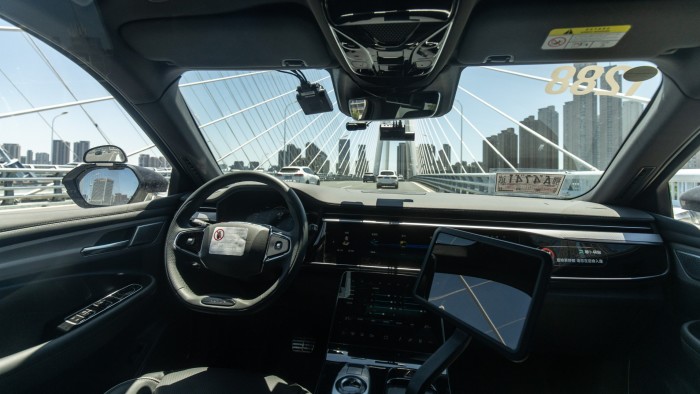Chinese carmakers have shocked the world’s auto brands with their rapid adoption of electric vehicles. Now the battleground is shifting to autonomous vehicles and many experts believe China is again claiming an early advantage.
The battle sees US groups such as Tesla and Waymo, Google’s self-driving project, pitched against BYD, China’s biggest EV group, as well as robotaxis from Pony.ai, Baidu and WeRide.
While autonomous driving for several years was viewed as an Achilles heel for BYD, the Warren Buffett-backed group rocked the auto industry in January when it revealed plans to deploy its God’s Eye advanced driving system to 21 new car models, without additional charges for customers.
Tu Le, founder of the Sino Auto Insights consultancy, says BYD — which challenges Tesla for the crown of the world’s biggest EV maker — appears to be moving into pole position in the race to develop advanced driving assistance systems. These are technologies such as automatic emergency braking, adaptive cruise control and monitoring of driver attention and potential collisions, and are seen as forerunners to fully autonomous vehicles.
“When you ask me ‘who’s winning?’ I have to get back to ‘how many cars are being sold?’” Le says. “And if it is a numbers game — because we need to point back to how much data is being collected, how much data is feeding into the algorithm — then clearly that would indicate that BYD will win, because they are making it standard on every vehicle.”
As the fledgling autonomous driving industry grows, companies are vying for hundreds of billions of dollars in potential new revenues as logistics and transport fleets adopt vehicles expected to be safer, cheaper and more efficient.
This month, Goldman Sachs analysts forecast the value of China’s robotaxi market alone will surge to $47bn by 2035, from $54mn in 2025. This, the bank’s analysts said, would be driven by decreasing costs of hardware and algorithms. It estimates the unit cost of a vehicle with intelligent driving falling to $32,000 by 2035, from $44,000 today.
And coupled with the demise of the industry producing the internal combustion engine, the prospect of driverless cars is also opening the door to hardware and software companies.

Among the top contenders is Beijing-based Baidu, China’s rival to Google and its biggest robotaxi operator. In January the company said its Apollo Go vehicles provided 1.1mn rides to the public in the fourth quarter of last year, up 36 per cent year-on-year, and taking its cumulative rides to more than 9mn.
Excitement is also brewing over the emergence of Huawei, based in China’s tech manufacturing hub of Shenzhen, as another key challenger. While the world’s biggest telecoms group has no plans to build cars, it may be poised to dominate large swaths of the supply chain for autonomous driving despite being heavily targeted by US sanctions.
“Huawei has a distinct advantage,” says Le. “They’re trying to go completely vertical, meaning: building the chips, building the software, building the infotainment, building the data in the cloud.”
However, regulatory uncertainty may prove a constraint, both in China and the US, Shihao Fu, a technology analyst at IDTechEx, a UK-based tech research group, notes that while up to 10 per cent of new vehicle sales in China may be “L2-plus or L3 ready”, China’s current regulations do not yet permit their full operation at these levels. L2 technologies allow “hands-off, eyes on” driving, while L3 enables “hands-off, eyes-off” — but typically in only in predefined conditions. A big leap remains from these technologies to full driverless cars on all roads.
More stories in this report
Officials are being called on to answer difficult questions which stand in the way of the industry’s development, including over safety and liability, as more cars with self-driving functions take to Chinese roads. Their answers could define the pace of new technology becoming available, just as China tries to stay ahead of the US.
“The number one concern is definitely safety — the technology needs to be proven, that is non-negotiable,” says Raymond Tsang, an automotive technology expert with Bain in Shanghai. “The second [concern] is insurance and liability: when something bad happens, then who is responsible? The insurance company, or the manufacturer or the owner? That needs to be sorted out.”
Meanwhile in the US, Tesla will launch a driverless ride-hailing service in Austin, Texas, by June and start production of a fleet of autonomous vehicles next year. But regulatory questions are also emerging in the US over whether Elon Musk’s so-called “Cybercabs” would be allowed to drive on American roads without pedals or a steering wheel.
Another uncertainty stems from the trade war between the US and China, which threatens to further decouple the world’s biggest economies. In this context, Christoph Weber, who leads the China business of Swiss engineering software group AutoForm, says Germany’s Volkswagen appears well-positioned to stay in the autonomous driving fight.
Watch the FT Future of the Car summit
May’s London conference featured senior industry figures and FT journalists. Pay to view video of all sessions at car.live.ft.com
VW was in recent years caught off guard by Chinese advances and its share in the world’s biggest auto market has been battered. But it has since overhauled its global strategy. Now, Weber says, VW appears to be essentially becoming “two companies”, one in China and one in the US, with separate tech platforms, supply chains and research and development teams.
“This split in geopolitics and technology between the US and China is happening. And they have a very clean answer,” he says. “Maybe some people don’t like this answer because basically it means you have to double your investment and resources. But having two platforms, one west, one east, that is actually reasonable.”
